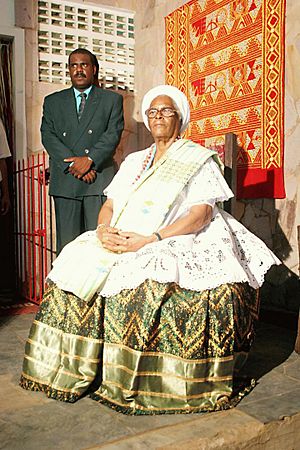Mãe Stella de Oxóssi facts for kids
Mãe Stella de Oxóssi (born Maria Stella de Azevedo Santos, May 2, 1925 – December 27, 2018) was a very important spiritual leader. She was a iyalorixá, which means a high priestess, in the Brazilian Candomblé religion. She was also known by her spiritual name, Odé Kayodê.
Mãe Stella was the fifth chief priestess of Ilê Axé Opô Afonjá. This is a famous Candomblé terreiro, or temple, located in Salvador, Bahia, Brazil. Before becoming a spiritual leader, she trained and worked as a public health nurse. She joined the Candomblé religion in 1939. Later, in 1976, she became the iyalorixá of Ilê Axé Opô Afonjá. Mãe Stella was special because she wrote books and articles about Candomblé. She helped many people learn about its beliefs and practices.
Contents
Early Life and Education
Mãe Stella de Oxóssi was born in Salvador, Brazil. She was the fourth daughter of Esmeraldo Antigno dos Santos and Thomázia de Azevedo Santos. Sadly, she became an orphan and was raised by her aunt.
She went to the Federal University of Bahia. There, she studied at the School of Nursing and Public Health. After graduating, Mãe Stella de Oxóssi worked as a community health nurse. She helped people in her community for over thirty years.
Becoming a Candomblé Leader
Mãe Stella was initiated into Candomblé on September 12, 1939. She was only 14 years old at the time. Her initiation was led by Mãe Senhora, a respected spiritual leader. During this time, she received her spiritual name, Odé Kayodê.
She continued to study under Mãe Senhora at Ilê Axé Opô Afonjá. This lasted until Mãe Senhora passed away in 1967. On March 19, 1976, Mãe Stella was chosen as the fifth iyalorixá of Ilê Axé Opô Afonjá. She took over after Mãe Ondina de Oxalá. In the same year, she retired from her nursing job.
Promoting Candomblé Culture
Mãe Stella de Oxóssi traveled to Yoruba holy sites in Osogbo, Osun State, Nigeria in 1981. This trip helped start important religious and cultural exchanges. It connected Candomblé communities in Brazil with Yoruba communities in Nigeria.
She also started writing articles and books about Candomblé traditions. Before this, much of the religion's knowledge was passed down orally. Her writings helped share these traditions with a wider audience. In 1981, she opened the Ohun Lailai Museum. This was the first public museum connected to a Candomblé terreiro. The museum showed clothing, ritual objects, and instruments used in Candomblé. These items were mostly unknown to the public before the museum opened.
Mãe Stella worked hard to get Ilê Axé Opô Afonjá recognized. She wanted it to be seen as a protected historic site. Thanks to her efforts, the terreiro was recognized by the National Institute of Historic and Artistic Heritage (IPHAN) in 1999.
Mãe Stella's Beliefs
Mãe Stella de Oxóssi was known for her strong views against syncretism. Syncretism is when different religions mix together. For a long time, Candomblé practices often mixed with Catholicism in Brazil.
While she believed in respect between religions, she said, "I am not against the Catholic Church, but against syncretism." She encouraged removing statues of Catholic saints from Candomblé altars. She also preferred using the Yoruba language term iyalorixá instead of the Portuguese mãe de santo. Mãe Stella believed in using Yoruba language for names and religious ceremonies.
Later Life and Passing
In 2017, Mãe Stella de Oxóssi moved to Nazaré das Farinhas in Bahia. This was after she had a stroke. She passed away in Santo Antônio de Jesus on December 27, 2018. After some discussion about where she should be buried, Mãe Stella was laid to rest in Salvador.
See also
 In Spanish: Mãe Stella de Oxóssi para niños
In Spanish: Mãe Stella de Oxóssi para niños


